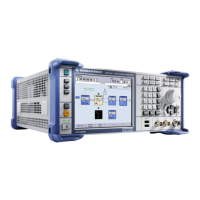Instrument Function
R&S
®
SMBV100A
332Operating Manual 1176.8016.02 ─ 17
SCPI Command: BB:DM:CLOC:SYNC:MODE MAST
3. Perform "Set Synchronization Settings".
SCPI Command: BB:DM:CLOC:SYNC:EXEC
The synchronization settings are automatically set.
The synchronization clock (including the trigger signal) and the reference clock of
the master instrument are output on the CLK OUT and the REF OUT connectors
and supplied to the slave instrument.
Step 3: Configure Slave Instrument(s)
For working in master-slave synchronous mode, the slave instrument(s) has (have) to
be configured as follow:
1. Configure the instrument to generate a baseband signal with the same settings as
the master one and activate signal generation.
2. Adjust the state of the parameter "Trigger/Marker/Clock > Sync. Output to External
Trigger" as follow:
a) Disable the parameter, if the master instrument provides the slaves with its
internal trigger signal.
b) In case a common external trigger signal is provided for the master and the
slave instrument(s), the state of this parameter in all instruments has to match.
SCPI Command: BB:DM:TRIG:EXT:SYNC:OUTP OFF
3. Set the "Sync Mode" to "Sync Slave".
SCPI Command: BB:DM:CLOC:SYNC:MODE SLAV
4. Perform "Set Synchronization Settings".
SCPI Command: BB:DM:CLOC:SYNC:EXEC
5. Select "Trigger/Marker/Clock > Global Trigger/Clock/External Input Settings >
Automatic Delay Compensation" and adjust the "Slave Position in Chain" and
"Cable Length". Enable the automatic delay compensation.
Following parameters are set automatically:
● The "Reference Oscillator" source is set to external.
● The "Trigger Mode" is set to retrigger and the "Trigger Source" is set to exter-
nal.
● The "Clock Source" is set to external.
The slave instrument receives the synchronization clock (including the trigger sig-
nal) and the reference clock of the master one.
Baseband Signal - Baseband Block

